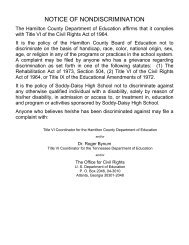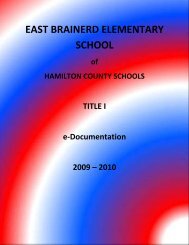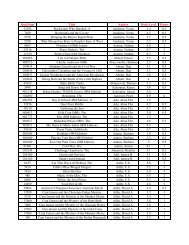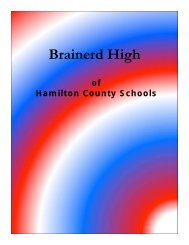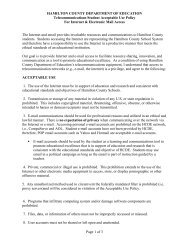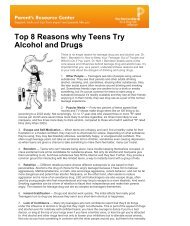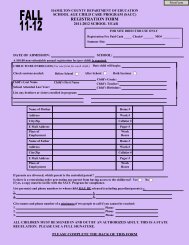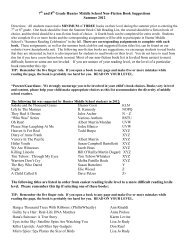RESOURCE PACKET Assessment of Language Impairment
RESOURCE PACKET Assessment of Language Impairment
RESOURCE PACKET Assessment of Language Impairment
You also want an ePaper? Increase the reach of your titles
YUMPU automatically turns print PDFs into web optimized ePapers that Google loves.
Page 2 <strong>of</strong> 2<br />
II. INTENTS (“why”)—continued Verbal Other<br />
B. Responses<br />
1. Yes/No Answers_________________________________________________ _________<br />
2. WH Answers____________________________________________________ _________<br />
3. Agreements_____________________________________________________ _________<br />
4. Compliances—comply with or refusing to comply________________________<br />
5. Qualifications—supplying unexpected information_______________________<br />
6. Imitations—part or whole repetitions <strong>of</strong> prior utterances___________________<br />
C. Descriptions<br />
1. Greetings_______________________________________________________<br />
2. Identifications—labeling object, person, event, situation___________________<br />
3. Possessions—indicating ownership___________________________________<br />
4. Events—actions, processes described_________________________________<br />
5. Properties—observable traits or conditions <strong>of</strong> objects, events, situations______<br />
6. Locations—location or direction <strong>of</strong> an object or event_____________________<br />
7. Times—times are reported__________________________________________<br />
_________<br />
_________<br />
_________<br />
_________<br />
_________<br />
_________<br />
_________<br />
_________<br />
_________<br />
_________<br />
D. Statements<br />
1. Rules—express rules, conventional procedures, analyze facts, definitions<br />
or clarifications___________________________________________________ _________<br />
2. Evaluations—impressions, attitudes, judgments about objects, events,<br />
situations______________________________________________________ _________<br />
3. Internal Reports—emotions, sensations, mental events, including intents to<br />
perform future acts________________________________________________ _________<br />
4. Attributions—beliefs about another’s internal state, capacity or intents________ _________<br />
5. Predicting—beliefs about future actions, events, situations_________________ _________<br />
6. Explanations—reasons, causes, predictions____________________________ _________<br />
7. Hypothesizing—attempt to explain assumptions or verifiable future facts______<br />
_________<br />
E. Acknowledgments<br />
1. Acceptances—neutrally recognize answers or non-requests________________ _________<br />
2. Approval/Agreements—positively recognize answers or non-requests________ _________<br />
3. Disapproval/Disagreements—negatively evaluates answers or nonrequests___________________________________________________________<br />
_________<br />
_________<br />
_________<br />
_________<br />
_________<br />
_________<br />
_________<br />
_________<br />
_________<br />
_________<br />
_________<br />
_________<br />
_________<br />
_________<br />
_________<br />
_________<br />
_________<br />
_________<br />
_________<br />
_________<br />
_________<br />
_________<br />
_________<br />
_________<br />
F. Performatives<br />
1. Role-Plays—establish a fantasy______________________________________ _________<br />
2. Protests—object to listeners previous behavior__________________________ _________<br />
3. Game-Markers—initiate, maintain, or end a game________________________ _________<br />
4. Jokes___________________________________________________________ _________<br />
5. Claims—establish rights by being said (“that’s my cookie”)_________________ _________<br />
6. Warnings—alert listener to impending harm_____________________________<br />
_________<br />
7. Teases—annoy, provoke, taunt______________________________________<br />
_________<br />
G. Miscellaneous<br />
1. Uninterpretable—unintelligible, incomplete, or anomalous utterances__ _________<br />
2. Exclamations—emotional reactions_____________________________ _________<br />
_________<br />
_________<br />
_________<br />
_________<br />
_________<br />
_________<br />
_________<br />
_________<br />
_________<br />
ED –4072 / Rev. 07.09<br />
Department <strong>of</strong> Education<br />
<strong>Language</strong> <strong>Impairment</strong> Resource Packet




